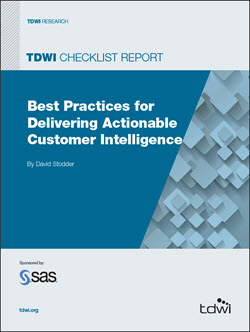
TDWI Checklist Report | Best Practices for Delivering Actionable Customer Intelligence
October 9, 2015
In every industry today, businesses feel a fierce urgency to become
customer-centric. They want to know what they can do to preserve
and expand existing customer relationships and attract the best new
customers. They are looking to business intelligence (BI), analytics,
and supporting big data, data warehousing, and customer data
management platforms to help them drive smarter decisions and
actions in marketing, sales, service, e-commerce, and other customer-facing
activities. With new analytic insights, companies seek to
more easily identify how to streamline and improve their operations
and innovate in the development of business-to-business (B2B) and
business-to-consumer (B2C) products and services.
This interest is surging at a time when customer data sources are
expanding, challenging organizations to ingest and analyze this
tsunami of data and distill it into actionable insights. Adding to the
challenge is that customer engagements are occurring across diverse
channels. Data generated by customers is both structured and
unstructured; joining traditional sources such as sales transaction
records are new, less-structured sources such as social media activity.
Gaining an integrated view that uncovers hidden data relationships
between these sources can be invaluable to improving customer
intelligence. The hard part, however, is filtering the data “noise”
to sharpen focus on the most relevant information for marketing
campaign decisions, sales strategies, call center performance
management, online engagement, and more.
The data is valuable, but it is of little actionable benefit if users
cannot interact with it effectively to share insights in presentations,
e-mail, texts, and meetings. New tools that combine the powers of
data visualization with easier-to-use analytics are maturing, making it
possible for nontechnical business users to do more on their own with
less reliance on IT developers and data science experts—valuable as
they continue to be.
This Checklist offers seven best practices for formulating a strategy to
derive and deliver actionable customer intelligence. The practices are
aimed at helping organizations turn their increasingly voluminous data
riches into competitive business advantage.